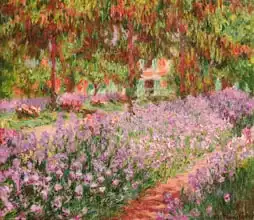About this finishing
Print. The image is printed on the top quality 10-ink HP Z9PS printer on HP matte 270 g / m2 paper. You can choose any size to an accuracy of 1 cm. A margin of 5 cm around the image is added to the size of the motif.


You can find a detailed description about our finishings
here.
The Garden at Giverny
Date:
1900Medium:
oil on canvasLocation:
private collection"Garden at Giverny" by
Claude Monet is a series of paintings in which the artist captured the charm of his own garden in the village of Giverny, which he owned. One of the most famous paintings in this series is "Water Lilies and the Japanese Bridge," which is one of Monet's many works in which he focused on his own garden. Monet often focused on
water lilies and a Japanese bridge in his garden. These elements are key to his Giverny series and are evident in many of the paintings. Monet used his signature Impressionist style, which emphasizes
impression and atmosphere before the painting. His brush captured light reflections, colors and movements with a hint of abstraction. The garden at Giverny was full of diverse flowers that Monet often depicted in his paintings. You can expect a varied palette of colors and different types of flowers. Monet was a master at working with color and light. His paintings reflect different shades of light at different times of the day and seasons. Monet's garden was a place of peace and inspiration. His paintings often create an impression of calm and harmony that unites nature and art.
Monet painted picture The Garden at Giverny in 1900. Prevailing color of this fine art print is green and its shape is landscape. This art piece is located in a private collection This image is printed on demand - you can choose material, size and finishing.
Claude Oscar Monet (1840-1926). A native Parisian, who thoroughly developed the idea of
Impressionism. Monet almost scientifically studied the effect of light on different objects. He devoted himself to so called transitory states, which quickly led him to work with colour and light, his paintings acting on the viewer from the first impression. His use of open-air painting and objects which were special only because of light opened the way for the beginnings of modern painting. Monet’s
Impression, Sunrise (1874) not only gave the name to the whole art movement, but secured Monet a place among the best painters of all times. At one time, he resided in London and created his famous study
Houses of Parliament (Monet wondered, How could the English painters paint Parliament when it cannot be seen for the fog?). In the
Giverny, which became his favourite retreat after the death of his wife, he painted motifs from his garden and the popular series
Water Lilies - the world of the water was as poetic and mysterious as a primordial paradise.

